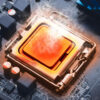Memory cards provide exceptional performance and reliability for mission-critical data and can be tailored to meet any application’s specific needs. However, a memory card can also be vulnerable and prone to unauthorized access by unencrypted or poorly secured SD and microSD card readers. While memory cards are convenient and affordable, they lack the same level of security as their larger counterparts.
This means that hackers can easily access confidential files stored on these cards. They can steal your data by simply copying a memory stick that has been inserted into your digital devices while you were using them.
Need for Encrypted SD Cards
Data-breach incidents have increased dramatically as businesses and governments become more and more aware of the threat posed by unprotected applications.
Unlike traditional SD cards, the new generation of memory cards offer high levels of security, featuring 256-bit Advanced Encryption Standard (AES) hardware-based encryption technology and customizable security features.
Self-Encrypting Drive
A self-encrypting drive (SED) is a privacy layer built into solid-state drives (SSDs) or Hard Drives. A self-encrypt SD card secures the data at rest before writing it to disk. The data remains encrypted until the SSD’s controller decrypts it. Once decrypted, the data is then written to the underlying storage area of the SSD. Encrypted SSDs are commonly used by companies to protect corporate secrets and intellectual property.
Hardware-Based Full-Disk SD Card Encryption
This generational MicroSD and SD card is an example of a self-encrypting drive with a hardware-based, full-disk encryption process, allowing for the creation of a fully encrypted partition within a single SD card.
This solution provides maximum security because all data is encrypted at rest. It does not require software to perform the encryption and decryption operations.
How Does Self-Encrypting Drive Work?
A self-encrypting drive (SED) encrypts data as it is written to the disk. The data remains protected as long as it stays on the drive. There is no need for an encryption password, PIN, command prompt, or any other method of controlling or monitoring access.
Each drive has a disk encryption key (DEK) assigned during manufacturing. This key is called the “AES key.” Each time the disk is powered on, the DEK automatically calculates a 256-bit cryptographic hash based on the disk’s sector size.
When a user logs onto this operating system, the DEK is presented to the OS for decryption. This ensures that only authorized users will decrypt SD card data. The DEK encrypts the data when the disk writes it and decrypts it when the disk reads it.
If the DEK does not match, the drive will mark the contents unreadable and inaccessible to recover data. The actual data will remain intact. There is no risk of losing content if a device is stolen or lost.
Accelerated Memory Encryption Solutions to Increasing Security Needs
At Accelerated Memory Production, Inc. we understand the importance of keeping your confidential data safe and secure from prying eyes. That’s why our microSD and SD solutions use the leading global encryption standard – Advanced Encryption Standard (AES)-256 in combination with Secure Key Management Technologies. These technologies make your data virtually impenetrable even in the event of physical theft or loss.
These high-performance encrypted SD card products are optimized for the demanding needs of industrial control programs that require tamper resistance, ruggedness, and reliability.
To learn more about our self-encrypting technology solutions, please contact us today!
Level up your storage with our premium SD and microSD cards.






